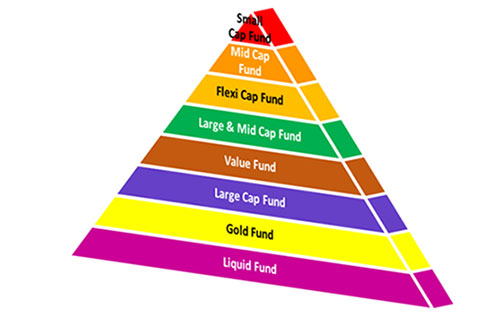How to Optimise Mutual Fund Returns And Reduce Investment Risk?
Ketki Jadhav
Feb 27, 2023 / Reading Time: Approx. 8 mins
Listen to How to Optimise Mutual Fund Returns And Reduce Investment Risk?
00:00
00:00
Building long-term wealth and reaching financial freedom require investing early in the right asset classes that align with your investment objective. The market offers a wide variety of investment options, making it difficult to choose the one that best suits your financial objectives and risk tolerance.
Mutual funds collect funds from various investors and invest in shares of publicly traded companies, government and corporate bonds, short-term money market instruments, other assets and securities, or a combination of these assets. Due to the simplicity of investing, diversification across different asset classes, and potential for inflation-beating returns, mutual funds are becoming increasingly popular among investors.
They give investors easy access to a variety of assets, such as stocks, bonds, and commodities, without requiring them to conduct their own research or keep track of them. This gives investors a chance to gain the skills of professional fund managers who research market trends, spot new investment opportunities, and actively manage the portfolio of the fund.
Here are 8 strategies that can help you optimise mutual fund returns and minimise investment risks:
1. Understand the risk-reward spectrum
You must realise as an investor that risk and return are two sides of the same coin. There is a certain amount of risk attached to every return you desire. Each asset class, including gold, real estate, debt, and equities, as well as the type of mutual fund scheme you select, has a different level of risk and reward.
 Source: PersonalFN Research
Source: PersonalFN Research
As you can see in the pyramid above, large-cap funds have lower risk and are more stable than their mid-cap and small-cap fund counterparts, but at the expense of return potential. Equities and equity-related instruments are at the higher end of the risk-return spectrum, whereas fixed-income products and debt instruments are considered low risk.
Investors typically think that in order to yield higher returns, they must take on higher risk. Nevertheless, it is not true; taking a high risk does not necessarily result in high returns. While taking high risks is not always a bad thing, it is important to employ tactics that help lower investment risk.
Take note no single method can be used to accomplish all of your financial goals because they would each demand a different time horizon and investment strategy. You may be able to achieve your goals by investing in certain carefully selected rewarding mutual funds, as they can help you in long-term wealth creation and yield inflation-beating returns.
2. Understand your risk profile
Investments in mutual funds are made depending on an investor's profile. Investor risk tolerance varies -- what one individual considers to be a good fund may not be the finest for another. One must consider their age, financial situation, the number of dependents, the time in hand to achieve the goal, and risk appetite while selecting a fund. For instance, equity-oriented mutual funds would be the best-suited funds if an investor has a long investment horizon and a moderate to high-risk tolerance. In comparison, debt funds would be the most appropriate category for an investor with a low-risk tolerance. Hence, instead of investing relying on advice from others, be sure the funds you choose are compatible with your risk profile.
 Image source: www.freepik.com
Image source: www.freepik.com
Join Now: PersonalFN is now on Telegram. Join FREE Today to get 'Daily Wealth Letter' and Exclusive Updates on Mutual Funds
3. Analyse different qualitative and quantitative factors
Analysing multiple qualitative and quantitative aspects is necessary in order to choose the mutual fund schemes that are best suited to your goals. While past scheme performance and risk-adjusted returns are among the quantitative parameters, some qualitative parameters include portfolio quality, fund management approach, fund manager's experience, funds-to-fund manager ratio, portfolio ratios and concentration, turnover ratio, investment systems and processes at the fund house, assets under management, and so on.
4. Do the right asset allocation
In order to do the right asset allocation, risk and reward must be balanced. Choosing the appropriate assets should be dependent on one's financial objectives. The time in hand to achieve your goal will assist in selecting the asset class. Debt funds are best for short-term objectives. Whereas equity mutual funds are considered appropriate for long-term objectives. Consequently, the appropriate asset class should be picked for investment depending on several qualitative, quantitative, and personal factors.
5. Diversify your portfolio
You must have heard of a common saying, "Don't put all your eggs in one basket." This means that you should not invest all your money in the same asset class. Investing in a mutual fund merely based on the past 1 to 5 years' performance has been a typical habit. In the end, it increases market risk, and you risk losing most of your investment during market downsides. Hence, it is always recommended to have exposure to a variety of asset classes as well as different sectors or types within each asset class. It helps in reducing risk concentration. If any one fund underperforms, there will always be another fund that will make up the loss.
However, the overlapping of themes and sectors may result from investing in too many funds. Hence, you need to pay attention to how your investment is distributed across your portfolio. Be sure your money is not being reinvested in identical securities.
6. Be prepared with a contingency fund
The performance of your portfolio might be impacted by non-financial hazards in addition to the financial risks associated with investing. For example, a medical emergency, loss of an earning member of the family, loss of job, etc. Your potential gains may be forfeited if your money is trapped in long-term investments like mutual funds, and you have to sell them at an inconvenient moment.
To defend against this risk, it makes sense to construct a contingency fund that comes in handy in desperate conditions without disturbing your long-term investments. This emergency fund ought to be placed in products that are immune to market swings, such as liquid funds that offer quick redemption. It is advised to devote approximately 10% of your entire portfolio to such funds. You can be ready for unforeseen eventualities by keeping the residual corpus in other funds with the potential to yield better returns.
It might be a good idea to switch your assets to a more conservative fund if you reach your financial objectives earlier than anticipated in order to protect your capital. Moving a portion of your investments to debt funds or hybrid funds, where risk is lowered by managing the proportion of equity and debt dynamically, can lower the risk level if you are actively invested in equity-oriented mutual funds and achieved your goal. Due to market volatility, continuing to invest in an equity fund after reaching your target can be dangerous. Therefore, transferring the corpus to an investment with lesser risk is crucial.
7. Start with SIPs
An SIP is an investment route offered by mutual funds wherein an investor can gradually invest a fixed amount in a mutual fund scheme of his/her choice at regular intervals.
So, the SIP instalment could be as low as Rs 500 a month and is similar to a Bank Recurring Deposit (RD). It is convenient as you can gradually invest in mutual funds by giving a standing instruction/debit mandate to your bank to debit the mentioned amount every month. Once you give a standing instruction to the bank, the specified amount gets deducted from your Savings Bank Account on a specified date and is invested in the selected mutual fund scheme in a steady manner. Depending upon the scheme, some fund houses offer SIP frequency of weekly, monthly, quarterly, half-yearly, etc. Amongst these, the monthly SIP is the most popular type. Since SIP allows you to invest a small amount periodically, you do not need to have a substantial amount to start investing in mutual funds.
With its sheer power of compounding and rupee cost averaging, the Systematic Investment Plan (SIP) method of mutual fund investment is the best option for both novice and seasoned investors to consistently develop a corpus and provide returns that outperform inflation over time. You can achieve your desired goals by just creating an SIP for each of them.
8. Get in touch with the professionals
Since there is so much financial information available today, it can be confusing for novice investors to make wise judgements. The lack of knowledge about S.M.A.R.T. financial planning causes many investors to make random investments based on advice from friends and family or even social media 'FinFluencers', which can be harmful to their financial security. Investing should be tailored depending on a person's financial situation, requirements, and objectives.
With the help of PersonalFN's SMART Fund Explorer, you may strategically plan your mutual fund investments if you are looking to invest for a certain financial goal. All you have to do is mention your S.M.A.R.T. financial goal (such as purchasing a home, funding a child's education, retiring, etc.), choose an appropriate time period for accomplishing your goal (such as 5 years, 10 years, etc.), enter the amount needed in today's terms to accomplish your goal, and then choose whether to invest in a lumpsum or SIP. After providing all the necessary information, select "Show Me My SMART Investment Plan".
The SMART Fund Explorer will provide you with the anticipated return (%CAGR) and investment value at the target date based on the information you entered (which is calculated considering a nominal inflation rate).
You will see two mutual fund investment plans (Plan A and Plan B) provided by the SMART Fund Explorer as you scroll down. The plans precisely outline the fund categories you can invest in, the percentage of assets allocated to each, the potential returns of each category, and the contribution to the weighted annual return. Depending on your risk profile, you can select any of the plans.
Also, by subscribing to PersonalFN's SMART Fund Explorer, you can immediately access the list of mutual fund schemes that are the best matches for your chosen plan. You will have the chance to start your mutual fund investment journey sensibly by using the list of mutual funds that our research team carefully considered and highly recommended.
KETKI JADHAV is a Content Writer at PersonalFN since August 2021. She is an MBA (Finance) and has over seven years of experience in Retail Banking. Ketki specialises in covering articles around banking, insurance, personal finance, and mutual funds and has been doing it for over three years now.